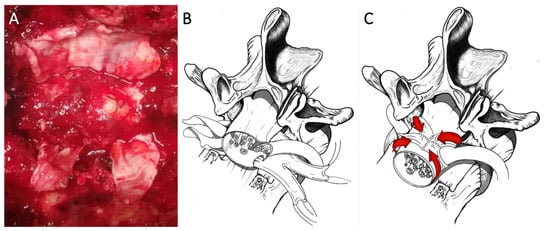Dural lacerations are relatively common findings in thoracic and lumbar spinal fractures. Differently from the posterior dural tears, the repair of the anterior ones is a challenge. Compared to all the documented strategies for obtaining a watertight closure of an anterior dural laceration, the coating techniques revealed advantages of preserving neural structures, being adaptable to anterior and antero-lateral dural tears of any size.
1. Dural Coating
After the exposure of the dural tube, a blunt dissection of its ventral surface from the posterior wall of the vertebral body is performed, a sterile centimeter is inserted anteriorly surrounding the dural sac, and measures are taken for shaping a patch (Tutopatch®), adequately cut to entirely envelop the dural tube. The shaped patch is pinched at its angles by suture threads and these are made to slide flush to the posterior wall of the vertebral body. By pulling the threads, the patch slides under the dural sac reaching a position covering all its anterior surface from side to side. After having properly centered the patch on the tear and having folded its flaps onto the dorsal dural surface, a running suture to close the entire wrap is performed, being careful not to constrict the dural tube underneath by tightening the margins of the patch too much with the suture (Figure 1).
Figure 1. Coating technique. By pulling the threads (A), the patch slides under the dural sac reaching a position covering all the anterior dural surface from side to side (B,C). After having properly centered the patch on the tear and having folded its flaps onto the dorsal dural surface, a running suture for closing the entire wrap is performed (D,E).
2. Dural Coating Straddling Nerve Roots
Exploiting the same procedure aimed at dissection of the anterior surface of the dural sac from the posterior wall of the vertebral body and to measure the circumference of the dural tube for shaping a tailored patch, this latter is pinched at its angles by suture threads and is made to slide flush to the posterior wall of the vertebral body by pulling the threads. The patch slides under the dural sac reaching a position covering all its anterior surface from side to side. The Tutopatch® is adequately positioned on the antero-lateral dural tear close to the nerve root axilla and two cuts are made to form a slot long enough to accommodate the nerve roots of both sides without retracting them. After having folded the flaps of the patch onto the dorsal dural surface, a running suture to close the entire wrap is performed, being careful not to constrict the nerve roots tightening too much the suture of the loop of the dural patch surrounding them as a scarf (Figure 2).
Figure 2. Coating technique straddling nerve roots. Intraoperative image showing the dural sac, previously covered with a stitched fat graft, and the dural patch ready to be folded onto the dorsal dural surface (A). By pulling the threads, the patch slides under the dural sac, reaching a position covering the dural tear, and two cuts are made to form a slot long enough to accommodate both the nerve roots without retracting them (B). After having folded the flaps of the patch onto the dorsal dural surface, a running suture to close the entire wrap is performed, being careful not to constrict the nerve roots (C).
3. Dural Coating with Sutured Fat Graft
After the usual blunt dissection of the ventral surface of the dural sac from the posterior wall of the vertebral body, a sterile centimeter is inserted anteriorly surrounding the dural tube, and measures are taken to shape a patch (Tutopatch®). An autologous fat graft harvested from the subcutaneous tissue and with an adequate volume to plug the dural defect is stitched at the geometric center of the patch and this latter is pinched at its angles by suture threads. By sliding these flush to the posterior wall of the vertebral body and by pulling the threads, the patch slides under the dural sac reaching a position covering all the anterior dural surface from side to side and perfectly plugging the dural gap with its stitched fat graft. After having folded the flaps of the patch onto the dorsal dural surface, a running suture for closing the entire wrap is performed with the same precautions as for the standard dural coating (Figure 3).
Figure 3. Coating technique with sutured fat graft. An autologous fat graft (2.5 cm × 2.5 cm) harvested from the subcutaneous tissue is stitched at the geometric center of the patch and this latter pinched at its angles by suture threads (A). By pulling the threads, the patch slides under the dural sac reaching a position covering all the anterior dural surface from side to side and perfectly plugging the dural gap with its stitched fat graft (B). After having folded the flaps of the patch onto the dorsal dural surface, a running suture to close the entire wrap is performed (C).



